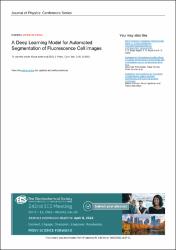A Deep Learning Model for Automated Segmentation of Fluorescence Cell images

Göster/
Erişim
info:eu-repo/semantics/openAccessTarih
2021Yazar
Aydın, MusaKiraz, Berna
Eren, Furkan
Uysallı, Yiğit
Morova, Berna
Özcan, Selahattin Can
Acılan, Ceyda
Kiraz, Alper
Üst veri
Tüm öğe kaydını gösterKünye
AYDIN, Musa, Berna KİRAZ, Furkan EREN, Yiğit UYSALLI, Berna MOROVA, Selahattin Can ÖZCAN, Ceyda ACILAN & Alper KİRAZ. "A Deep Learning Model for Automated Segmentation of Fluorescence Cell images". A Life in Mathematical Physics: Conference in Honour of Tekin Dereli, DERELI-FS 2021.Özet
Deep learning techniques bring together key advantages in biomedical image
segmentation. They speed up the process, increase the reproducibility, and reduce the workload
in segmentation and classification. Deep learning techniques can be used for analysing cell
concentration, cell viability, as well as the size and form of each cell. In this study, we develop
a deep learning model for automated segmentation of fluorescence cell images, and apply it
to fluorescence images recorded with a home-built epi-fluorescence microscope. A deep neural
network model based on U-Net architecture was built using a publicly available dataset of
cell nuclei images [1]. A model accuracy of 97.3% was reached at the end of model training.
Fluorescence cell images acquired with our home-built microscope were then segmented using
the developed model. 141 of 151 cells in 5 images were successfully segmented, revealing a
segmentation success rate of 93.4%. This deep learning model can be extended to the analysis
of different cell types and cell viability.
Kaynak
A Life in Mathematical Physics: Conference in Honour of Tekin Dereli, DERELI-FS 2021Bağlantı
https://iopscience.iop.org/article/10.1088/1742-6596/2191/1/012003/pdfhttps://hdl.handle.net/11352/4069


















